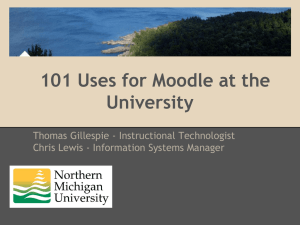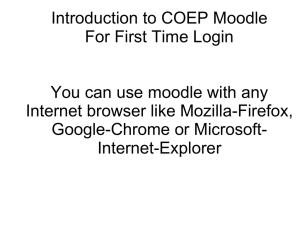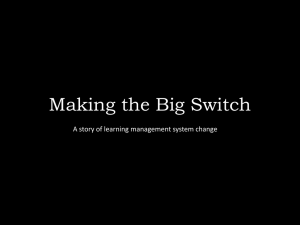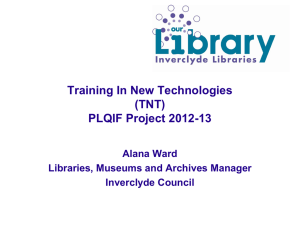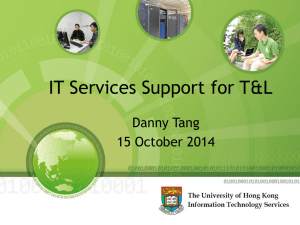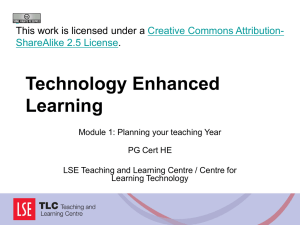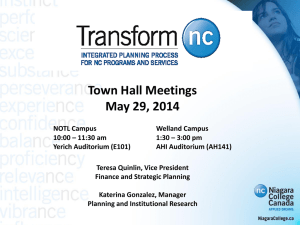potsdam - OpenScholar
advertisement
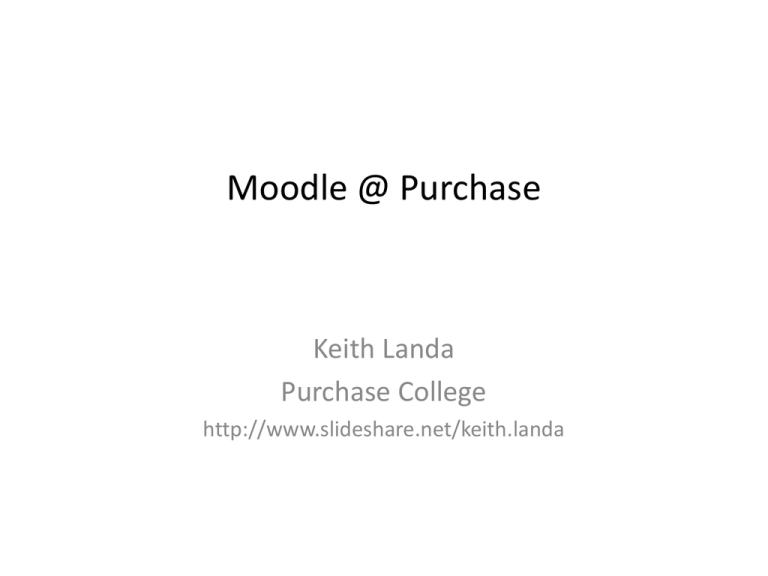
Moodle @ Purchase Keith Landa Purchase College http://www.slideshare.net/keith.landa Focus on teaching & learning - Robust set of activities & resources - Add-on modules from the community - Moodle development pathway Integration - Other systems - Web 2.0 world Why Moodle @ Purchase? Flexible open architecture Costs - No licensing costs - Similar support costs Risk management - Risks of open source - Commercial products have different risks Background – Purchase – 2008 Liberal Arts and Sciences plus Arts Conservatories ~4200 FTE ERes electronic reserves Web enhancement of F2F courses LMS review @ Purchase Context: faculty dissatisfaction with Blackboard; superficial use of LMS; escalating costs Fall 2008: faculty task force established; faculty survey; discussion of selection criteria (functionality, technical requirements, costs) Spring 2009: Moodle production system established; pilot Moodle courses (~20); student survey (key driver); ongoing communication; development of general sense among faculty that ‘we’re going with Moodle’…. Summer 2009: summer faculty workshop series (new); course conversion and course prep; consolidation of electronic reserves into Moodle courses Fall 2009/Spring 2010: transition year; immediate termination of ERes; one more year of Blackboard; faculty assisted to move courses to Moodle; ongoing Moodle workshops; termination of Blackboard at end of year Faculty Blackboard uses Course documents Syllabus Assignments Announcements Course info Grade center External links Discussion board Send email Staff information Course statistics Digital dropbox Course calendar Test manager Groups Early warning system Collaboration Messages Tasks Survey manager Safeassign Glossary manager 0% 20% 40% 60% 80% 100% LMS desired features 1. 2. 3. 4. 5. 6. 7. 8. 9. 10. 11. 12. 13. 14. 15. 16. Distribute materials Library services Integration with SIS Course communications Links to external web sites One stop shopping for students Discussion forum Gradebook New media (blogs, wikis, podcasts) Drop boxes Student collaboration tools Course reports Self-directed lessons Online quizzing Real-time tools (chat, etc) Clickers No “killer app” tying us to Blackboard Student Survey Responses Accessing resources 70% 60% 50% 40% 30% 20% 10% 0% Assignments Moodle Equal Blackboard Ease of use 70% 60% 50% 40% 30% 20% 10% 0% Better function Moodle Equal Blackboard Ease of use Blackboard Better function Keeping track of grades 70% 60% 50% 40% 30% 20% 10% 0% Better function Moodle Equal Blackboard Ease of use Schedule tracking 70% 60% 50% 40% 30% 20% 10% 0% Equal Ease of use Course communications 70% 60% 50% 40% 30% 20% 10% 0% Moodle Better function Which system preferred? 70% 60% Moodle 50% 40% Moodle Equal 30% Equal Blackboard 20% Blackboard 10% Ease of use Better function 0% 1 Implementation – course migration • Blackboard - ~1000 courses; ERes – substantially more • ERes – document download, upload to Moodle • Blackboard – Moodle can import Blackboard course archives (zip files), but…. (problems with the Bb archives) • Temp services staff - ~300 hours from May to Aug 2009, primarily ERes migration • Bb course migration on request during 2009/2010 year Implementation – faculty development • Spring 2009 workshops: hour long sessions, various topics; early adopters; 28 faculty • 2009 Summer Faculty Workshop Series: new programming, not just Moodle; half- and fullday workshops; stipends; 36 faculty at Moodle sessions • Fall 2009: Moodle Kickoff workshops; Getting Started, Gradebook, Learning Activity; 98 faculty Implementation – server config • Virtual servers for production and for test/dev – More control over test environment • • • • • Windows Server 2008 x64 4 CPUs 4 GB RAM 30 GB C: drive; 100 GB E: drive MS SQL and PHP Cost comparisons Blackboard Moodle Licensing $40K $0K Server VM VM Staff Fraction FTE server admin 1 FTE instructional tech Fraction FTE server admin 1 FTE instructional tech Course migration NA $3K onetime (ERes, mostly) Faculty development ?? $3.6K summer 2009 Switch to Moodle saves us over $50K each year (Blackboard and ERes licensing costs) Risk management: self-host vs vendor host http://goo.gl/tQ5uX Community contributed modules Lightbox Gallery resource Map activity Community Modules and Plugins page http://moodle.org/mod/data/view.php?id=6009 Bringing the cloud into the course Open advantages Enrollment automation Student Information System Academic Analytics Library Information Systems Campus Repository Senior projects Library integration -Reserve requests -Electronic resources Focus on teaching & learning - Robust set of activities & resources - Add-on modules from the community - Moodle development pathway Integration - Other systems - Web 2.0 world Why @ Purchase? Costs - No licensing costs - Similar support costs Risk management - Risks of open source - Commercial products have different risks Flexible open architecture Campus lessons - Moodle • LMS focus should be learning – Faculty AND student perspectives • Change is hard, and exhilarating • Choose the risk you’re comfortable with • Importance of community critical mass for open source apps • Clear roadmap for product development Student Information System Academic Analytics Library Information Systems Campus Repository The View from 30,000 Feet Community of Inquiry model Student engagement • with content • with instructor • with each other http://communitiesofinquiry.com/ 7 Principles of Good Practice 1. Encourages contact between students and faculty 2. Develops reciprocity and cooperation among students. 3. Encourages active learning. 4. Gives prompt feedback. 5. Emphasizes time on task. 6. Communicates high expectations. 7. Respects diverse talents and ways of learning. LMS orientations • Example Blackboard course • Example Moodle course – Main page sections – Blocks – Moodle navigation – Course page mirrors class, integrated resources and learning activities – “Scroll of death” Setting up a learning module • Defining the module – Using the section summary • Module learning objectives – Add a resource -> Compose a web page – Name and Full text fields – Window options • Creating organization: use of Labels Student engagement w/ content • Context & student engagement w/ the content • Files: your private staging area – – – – Linking to specific files Displaying a directory (folder) / image gallery File links in Moodle text Media filters • Linking to web sites • Integrating with Web 2.0 resources – Repositories in Moodle 2.0 – YouTube, Vimeo, VoiceThread, Google Docs Discussion forums • Student engagement with peers & instructor • Student-faculty contact; feedback; active learning • 4 forum types in Moodle (now 5 in 2.0) – Ex: single topic format; YouTube discussion – Q&A forum; reading reflection example • Rating discussion forums Student collaboration • Reciprocity and active learning • Wiki activity – Configuration and use – Pedagogical considerations: combined use of group forum and wiki project • Database activity – Structured contributions; activity configuration – Commenting and rating – Glossary activity Communication tools • Course announcements (News Forum) – Tie to Latest News block – Forum archive and email to class members • Moodle messaging – IM functionality within Moodle – Email notices – Permanent archive • Chat activity (eg, office hours) • Calendar and Upcoming Events Assignments in Moodle • Feedback; student/faculty engagement/contact • Assignment types; configuration • Student and faculty views • Grading and providing feedback Quizzes / Assessments • Question bank – Question types – Organizing questions – Question import • Configuring quizzes – Formative vs summative – Question selection – Feedback options Course reports • • • • • Course logs Participation reports Activity reports Student activity reports Connection between reports and messaging Questions? Keith Landa Purchase College SUNY 914-251-6450 keith.landa@purchase.edu
